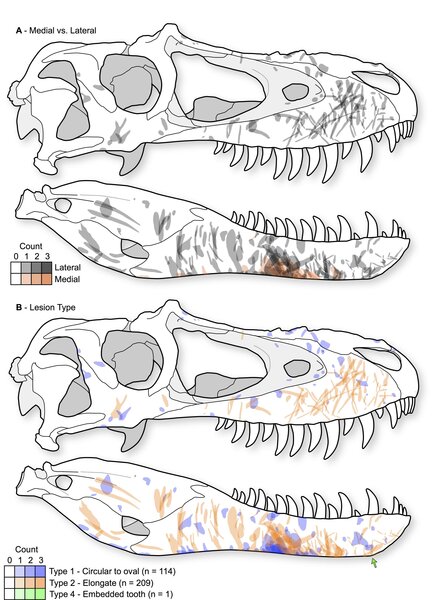Create a free profile to get unlimited access to exclusive videos, sweepstakes, and more!
Tyrannosaurs ripped each other’s faces off so they could get what they wanted

Creatures are always competing for something, from food to mates to territory, but some of them get more heated than others — as in, ripping their opponents' faces off.
Tyrannosaurs are already known for their viciousness. Why else would T. rex be the star of so many prehistoric horror movies? Now paleontologist Caleb Brown and his team of researchers have found one more reason that the outsize temper of tyrannosaurs on the big screen is more than just a stereotype. T. rex and its sharp-toothed, big-mouthed relatives used to face off in biting matches so violent that tooth marks were left on their skulls.
Why these carnivores turned on each other is unknown. What Brown, who led a study recently published in Paleobiology, could tell from examing over 200 tyrannosaur skulls was the size these beasts were when they started to fight, and how their brutal brawls played out. From what the scars say, they would size each other up before having at it with their jaws, and the aftermath was bloody.
“After looking at hundreds of scars, there was an obvious pattern that started to become clear,” Brown tells SYFY WIRE. “The scars consistently occurred in the same areas and orientations, suggesting repeated actions. Tyrannosaurs were biting down on the top of the skull, biting up on the bottom of the lower jaw, and landing glancing blows on the sides.”
Meaning, they were trying to see who could get those jaws around the other’s skull the fastest. There were round scars, probably from teeth puncturing bone, often found at the top of the muzzle. There were longer scars that looked more like the deep gashes of the biter’s teeth trying to sink in, with the one being bitten making every effort to get loose. The opposite tended to happen in lower jaws. Puncture scars were on the bottom of the jaw, while longer scars dragged up the sides. Gash scars often went downward and towards the back of the skull.
The position of the gashes started to give Brown a mental image of tyrannosaurs standing with their heads next to each other, but in opposite directions. There were other aspects of scarring that told him who was the biter and who was being bitten. It wasn’t an easy differentiation of attacker and victim. Both were gnashing their teeth at each other’s heads repeatedly, but most of the time, it was usually only the victim’s side that ended up preserved. Most scars showed signs of healing. While this means most fights weren’t lethal, it was still possible some were.
“Some of the specimens show scars that look only partially healed,” Brown says. “It is unclear if these animals died from other causes while they were healing, or died from their wounds a long time after the fight. We do see unhealed bite marks, but they are very rare.”
If a dinosaur was taken down, sometimes it didn’t die from loss of blood, but from infection. Fossils have evidenced signs of bone infections that eventually spread and killed the victim. Most of them likely walked away licking their wounds and their pride, going about their usual business of stalking prey and being fearsome until another opportunity to get down came along. Crocodilians often get caught up in fights like this, and usually survive. At least comparing the spacing between tyrannosaur teeth was evidence that the dinosaurs were both monstrous.
While it is really difficult to tell the sex of a dinosaur unless you have an entire skeleton of a pregnant female or one that clearly laid eggs (and may have died while sitting on top of them), the fact that the skulls were from larger individuals rather than juveniles must have meant that they had reached sexual maturity. That is when many animals start to get territorial and battle others for a mate. If juveniles were testing out their fighting and biting skills, Brown thinks they might have not been able to leave marks deep enough in the bone to incriminate themselves.
“Without definite proof of when sexual maturity starts, it is difficult to compare this to the pattern of bite scars,” he says. “Another problem is that these scars may just be size related, but the onset of bites across different species seems to correlate more with age than with absolute size of the dinosaur.”
So yeah, apparently whatever reputation those animatronic movie tyrannosaurs got is deserved.




























